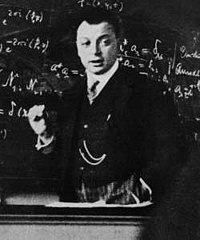
Photo from wikipedia
Violations of the Pauli Exclusion Principle (PEP), albeit small, could be motivated by physics beyond the Standard Model, ranging from violation of Lorentz invariance to extra space dimensions. This scenario… Click to show full abstract
Violations of the Pauli Exclusion Principle (PEP), albeit small, could be motivated by physics beyond the Standard Model, ranging from violation of Lorentz invariance to extra space dimensions. This scenario can be experimentally constrained through dedicated, state-of-the-art X-ray spectroscopy, searching for a forbidden atomic transition from the L shell to the K shell already occupied by two electrons. The VIP-2 Experiment located at the underground Gran Sasso National Laboratories of INFN (Italy) tests PEP violations by introducing new electrons via a direct current in a copper conductor, measuring the X-ray energies through a silicon drift detector. Bayesian and frequentist analyses of approximately six months of data taken with the fully operational setup is presented, setting the strongest limit to date on the PEP violation shown by the VIP collaboration. The upper bound on PEP violation are placed at 90% CL β2/2≤6.8×10−42 with the Bayesian approach, and β2/2≤7.1×10−42 with the frequentist CLs technique.
Journal Title: Symmetry
Year Published: 2022
Link to full text (if available)
Share on Social Media: Sign Up to like & get
recommendations!